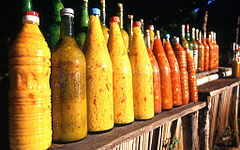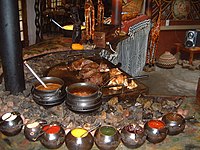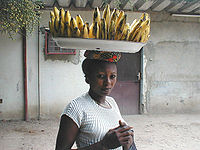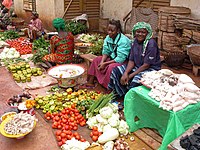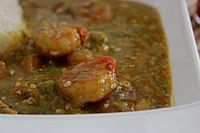List of African cuisines
This article should specify the language of its non-English content, using {{lang}}, {{transliteration}} for transliterated languages, and {{IPA}} for phonetic transcriptions, with an appropriate ISO 639 code. Wikipedia's multilingual support templates may also be used. (April 2021) |

This is a list of African cuisines. A
Central African cuisine
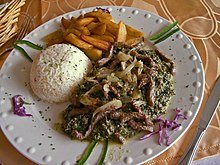
Central Africa stretches from the Tibesti Mountains in the north to the vast rainforest basin of the Congo River, the highlands of Kivu and the savana of Katanga.
This region has received culinary influence of the Swahilis (culture that evolved via the combination of Bantu, Yemeni, Omani and Indian cultures) during the East African Slave Trade. Swahili culinary influences can be found in dishes such as mandanzi, pilaf rice, kachumbari, sambsusa, and kuku paka.[3]
Central African cuisine has also been influenced by the Portuguese, by way of the
The Portuguese culinary influence is especially prominent in Angola, Sao Tomé and Equatorial Guinea. Central Africa has also been influenced by the cuisine of the regions East, West and Southern Africa because of their close proximity, e.g. babuté/bobotie is shared with the south, nyama choma with the east and gombos with West Africa.
The main ingredients are
Cassava plants are also consumed as cooked
- Cameroonian cuisine is one of the most varied in Africa due to its location on the crossroads between the north, west, and center of the continent; added to this is the profound influence of French food, a legacy of the colonial era.
- Congolese cuisine (Democratic Republic of the Congo) is one of the most diverse cuisines of the continent since it sits between east and southern Africa and received culinary influence from the Portuguese and Middle Eastern and Indian influences via the Swahili. Moambé chicken is the national dish.
- Centrafrican cuisine in the Central African Republicincludes Middle Eastern and French influences.
East African cuisine
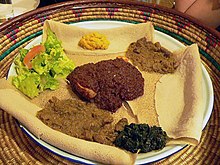
- East African cuisine: East Africa is the eastern region of the African continent, variably defined by geography or geopolitics. In the UN scheme of geographic regions, 19 territories constitute Eastern Africa:[13] This is a vast region with many diverse cuisines.
- manioc.
- Eritrean cuisine is a fusion of Eritrea's native culinary traditions, and the area's long history of trade and social interchanges with other regions and cultures.
- Ethiopian cuisine and Eritrean cuisine characteristically consist of spicy vegetable and meat dishes, usually in the form of wat (or wot), a thick stew, served atop injera, a large sourdough flatbread,[14] which is about 50 centimetres (20 inches) in diameter and made out of fermented teff flour.[14] Ethiopians eat with their right hands, using pieces of injera to pick up bites of entrées and side dishes.[14] Utensils are rarely used with this dish.
- Kenyan cuisine - There is no singular dish that represents all of Kenya. Different communities have their own native foods. Staples are maize and other cereals depending on the region including millet and sorghum eaten with various meats and vegetables. The foods that are universally eaten in Kenya are ugali, sukuma wiki, and nyama choma.
- Somali cuisine varies from region to region and is a fusion of native Somali culinary traditions with influences from Yemeni, Persian, Indian and Italian cuisines.
- and Pemba), spicy foods are common, and there is also much use of coconut milk. Regions in Tanzania's mainland also have their own unique foods.
- Arab, Asian and especially Indian influences. Like the cuisines of most countries, it varies in complexity, from the most basic, a starchyfiller with a sauce of beans or meat, to several-course meals served in upper-class homes and high-end restaurants.
- Maasai cuisine- The staple diet of the Maasai consists of cow's milk and maize meal. The cuisine also consists of soups from plants and fruits. More recently, the Maasai have grown dependent on food produced in other areas such as maize meal, rice, potatoes, and cabbage (known to the Maasai as "goat leaves").
North African cuisine

- North African or
- Arab, Ottoman and French cuisines.
- Nile Valley and Deltaproduce large quantities of high-quality crops.
- was an Italian colony.
- Tetouanrefined it over the centuries and created the basis for what is known as Moroccan cuisine today.
- Sudanese cuisine varies by region and has been influenced by the cross-cultural influences upon Sudan throughout history. In addition to the indigenous African peoples, the cuisine was influenced by Arab traders and settlers during the Ottoman Empire, who introduced spices such as red pepper and garlic.
- Berber people.
Southern African cuisine
- Afrikanerand British descent and their slaves and servants.
- mashed-up meat.
- Madagascar, located in the Indian Ocean off the south-eastern coast of Africa. Malagasy are mostly of Malayan Polynesian, along with African, Arab, Indian and European descent.[21] Rice is a common staple food, and fruits and vegetables are prominent in the cuisine. Pineapples, mangoes, peaches, grapes, avocados and lychee are grown on the island.[21] Meats include chicken, beef and fish, and curry dishes are common.[21] A common food is laoka, a mixture of cooked foods served with rice. Laoka are most often served in some kind of sauce: in the highlands, this sauce is generally tomato-based, while in coastal areas coconut milk is often added during cooking.[22]
- Mauritian cuisine is the cuisine of the island country of Mauritius. It is mostly influenced by the diverse cuisines of migrants to Mauritius.
- Afrikanerand British descent.
- South African cuisine is sometimes called "rainbow cuisine", as it has had a variety of multicultural sources and stages. Influences include indigenous practices and settler cookery that immigrants practiced. Their staple food is pap this is made using cornmeal and boiled water, South Africans also enjoy this dish served with braai meat. This is usually served at social gatherings.
- isitshwala and porridgeknown as bota or ilambazi. Zimbabwean cuisine also includes fruits and vegetables such as imbhida also known as African kale. Corn is also used to make dishes such as umxhanxa, which is made using boiled pumpkin and corn.
West African cuisine
- West African cuisine refers to many distinct regional and ethnic cuisines in West African nations, a large geographic area with climates ranging from desert to tropical.[24] Some of the region's indigenous plants, such as Hausa groundnuts, pigeon peas and cowpeas, provide dietary protein for both people and livestock.[25] Many significant spices, stimulants and medicinal herbs originated in the evergreen and deciduous forests of Western Africa.[25] Ancient Africans domesticated the kola nut and coffee, now used globally in beverages.[25]
- Ghanaian cuisine is the cuisine of Ghana. There are diverse traditional dishes. Foods also vary according to the season, time of the day and occasion.
- Côte d'Ivoire, or the Ivory Coast, and is based on tubers, grains, chicken, seafood, fish, fresh fruits, vegetables and spices and is very similar to that of neighboring countries in west Africa. Common staple foods include grains and tubers. Côte d'Ivoire is one of the largest cocoa producers in the world, and also produces palm oil and coffee.
- Nigerian cuisine - Like other West African cuisines, it uses spices and herbs in conjunction with palm oil or groundnut oil to create deeply flavored sauces and soups often made very hot with chili peppers. Nigerian feasts are colorful and lavish, while aromatic market and roadside snacks cooked on barbecues or fried in oil are plentiful and varied.[28]
- cassava bread, fried fish, and okrasoup.
- Senegalese cuisine has been influenced by nations like France, Portugal, and those of North Africa, and also by many ethnic groups, the largest being the Wolof; Islam, which first penetrated the region in the 11th century; and various European cultures, especially the French, who held the country as a colony until 1960.
- African foods and dishes
-
Traditional South African cuisine
-
A woman carrying bananas in the Democratic Republic of the Congo
-
Central market of Léo, Burkina Faso
-
Okra soup, Cameroon
By country
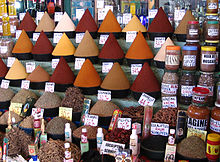

- North African cuisine
- East African cuisine
-
- Eritrean cuisine
- Kenyan cuisine
- Rwandan cuisine is based on local staple foods produced by the traditional subsistence-level agriculture and has historically varied between the country's different ethnic groups.[29]
- Somali cuisine
- South Sudanese cuisine
- Tanzanian cuisine
- Central African cuisine
- Portuguese colony for centuries, Portuguese cuisine has significantly influenced Angolan cuisine, with many foods imported into Angola by the Portuguese.[30]
- Cameroonian cuisine
- Centrafrican cuisine is the cooking traditions, practices, foods and dishes associated with the Central African Republic. The diet is heavy on staple starches such as millet and sorghum, and utilizes a significant amount of vegetables and sauces.[31]
- Republic of Chad. Chadians utilize a variety of grains, vegetables, fruits and meats. Commonly consumed grains include millet, sorghum and rice as staple foods.
- Democratic Republic of the Congo cuisine
- The Republic of the Congo cuisine
- Equatorial Guinean cuisine
- Gabonese cuisine is the cooking traditions, practices, foods and dishes associated with the sovereign state of Gabon. French cuisine is prevalent as a notable influence, and in larger cities various French specialties are available.[32] In rural areas, food staples such as cassava, rice and yams are commonly used.[31][33]
- São Tomé and Príncipe cuisine
- Southern African cuisine
- Botswana cuisine
- Comoros cuisine[clarification needed]
- Cuisine of Lesotho
- Malagasy cuisine encompasses the many diverse culinary traditions of the Indian Ocean island of Madagascar.
- Cuisine of Malawi
- Mauritian cuisine
- Mozambique cuisine - Present for nearly 500 years, the Portuguese greatly impacted the cuisine of Mozambique. Crops such as cassava (a starchy root) and cashew nuts (Mozambique was once the largest producer of these nuts), and pãozinho (pronounced pow-zing-yo; Portuguese-style bread rolls) were brought in by the Portuguese.
- Namibian cuisine
- Seychellois cuisine
- South African cuisine
- mealie meal. This may be eaten with a variety of vegetables, beans, meat, fish or sour milk depending on geographical location/origin.
- Zimbabwean cuisine
- West African cuisine
- vegetable fat.
- Burkinabé cuisine
- are seasonal.
- The Cuisine of Niger reflects many traditional African cuisines, and a significant amount of spices are used in dishes. Grilled meats, seasonal vegetables, salads and various sauces are some of the foods consumed.
- Gambian cuisine
- Ghanaian cuisine
- Guinean cuisine
- Guinea-Bissauan cuisine
- Ivorian cuisine
- Liberian cuisine
- Mali cuisine
- Mauritanian cuisine
- Nigerian cuisine
- Saint Helenian cuisine
- Senegalese cuisine
- Sierra Leone cuisine
- and fish.
See also
References
- ^ "Cuisine." Thefreedictionary.com. Accessed June 2011.
- ISBN 0-8065-1398-5. Archived from the originalon 16 December 2008. Retrieved 18 December 2008.
- ^ Coquery-Vidrovitch, Catherine; Mésnard, Éric (2013). L'esclavage intégré en Afrique (fin du xviiie-xixe siècle). Cahiers Libres.
- ^ Thronton, John (1981). "Early Kongo-Portuguese Relations: A New Interpretation". History in Africa. VIII (I): 22.
- ISBN 978-0-86442-138-8. Retrieved 30 November 2017.
- ISBN 978-0-85199-798-8. Retrieved 30 November 2017.
- ISBN 978-2-8317-1419-6. Retrieved 30 November 2017.
- ISBN 978-2-8317-1393-9. Retrieved 30 November 2017.
- ^ Whitford, J. (1877). Trading Life in Western and Central Africa. "Porcupine" Office. p. 212. Retrieved 30 November 2017.
- ^ Gibbons, A.S.H. (1898). Exploration and Hunting in Central Africa 1895-96. Methuen & Company. p. 223. Retrieved 30 November 2017.
- ^ "Food in Africa." World-food-and-wine.com. Accessed July 2011.
- ^ Robert, Nassau Hamill (1904). "Fetichism in West Africa: Forty Years' Observation of Native Customs and Superstitions." Congocookbook.com. Accessed July 2011.
- ^ "United Nations Statistics Division – Standard Country and Area Codes Classifications". Archived from the original on 13 July 2011. Retrieved 26 May 2013.
- ^ a b c Javins, Marie. "Eating and Drinking in Ethiopia." Archived 31 January 2013 at the Wayback Machine Gonomad.com. Accessed July 2011.
- ^ "Nile Perch." Aquaticcommunity.com. Accessed July 2011.
- JSTOR 1312084.
- ISBN 978-0-85112-235-9.
- ^ "Northern Africa." Foodspring.com. Accessed June 2011.
- ^ Mourad, Mazouz. "The Momo Cookbook." Archived 19 September 2011 at the Wayback Machine The Globalist. Accessed June 2011.
- ^ "Rainbow Cuisine in South Africa." Road Travel – Travel Group. Accessed July 2011.
- ^ a b c "Madagascar." Archived 4 May 2011 at the Wayback Machine African Studies Center, University of Pennsylvania. Accessed July 2011.
- ISBN 978-1-84162-341-2.
- ISBN 2-85744-946-1.
- ^ "Africa Climate." Backpack Traveller. Accessed July 2011.
- ^ a b c "Food and the African Past." Archived 10 October 2012 at the Wayback Machine Ucpress.edu. p. 14.
- ^ "Oxfam's Cool Planet - Food in Burkina Faso". Oxfam. Archived from the original on 17 May 2012. Retrieved 21 May 2008.
- ^ Marchais, p. 99
- ^ H.O. Anthonio & M. Isoun: "Nigerian Cookbook." Macmillan, Lagos, 1982.
- ^ Adekunle, p.81
- ^ Adebayo Oyebade, Culture and Customs of Angola (2007). Greenwood, p. 109.
- ^ a b "Foodspring® - finest fitness food". Archived from the original on 16 August 2011. Retrieved 17 June 2011.
{{cite web}}: CS1 maint: bot: original URL status unknown (link) - ^ "Foodspring® - finest fitness food". Archived from the original on 16 August 2011. Retrieved 29 November 2017.
{{cite web}}: CS1 maint: bot: original URL status unknown (link). - ^ "Gabon." Archived 15 October 2011 at the Wayback Machine Worldtraveltips.net. Accessed June 2011.
- ^ "Food habits of rural Swazi households" (PDF). Archived from the original (PDF) on 6 June 2011.
- ^ "Swaziland Food and Drink". Archived from the original on 19 September 2008.
- ^ "Sharing the Secrets of Togo's Cuisine." Madison.com. Accessed July 2011.
Further reading
- Adekunle, Julius (2007). Culture and Customs of Rwanda. ISBN 978-0-313-33177-0.



